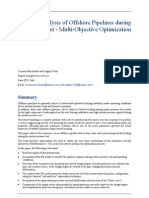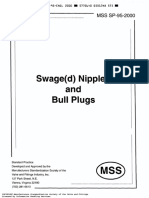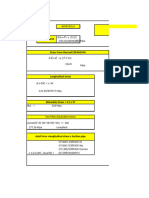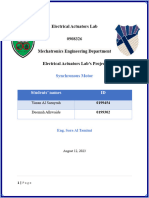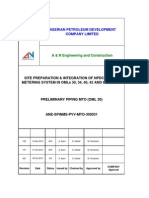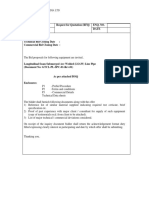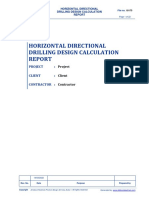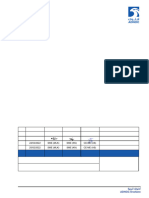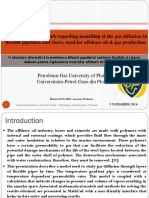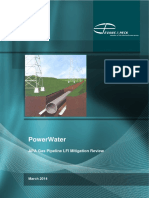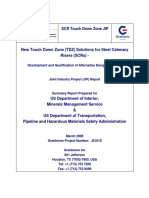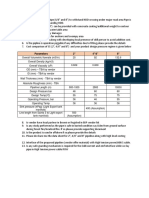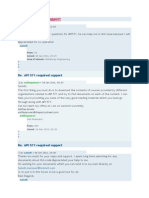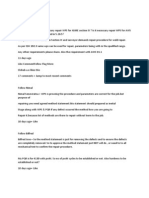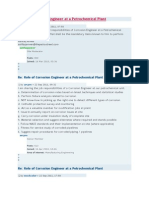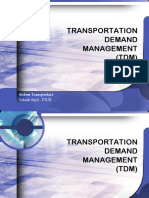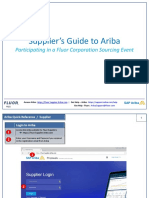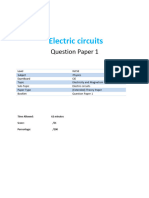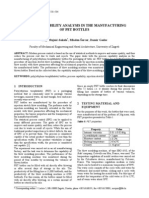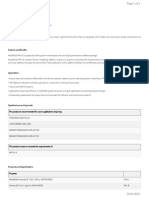Project Brief For Orcaflex
Project Brief For Orcaflex
Uploaded by
yogacruiseCopyright:
Available Formats
Project Brief For Orcaflex
Project Brief For Orcaflex
Uploaded by
yogacruiseOriginal Title
Copyright
Available Formats
Share this document
Did you find this document useful?
Is this content inappropriate?
Copyright:
Available Formats
Project Brief For Orcaflex
Project Brief For Orcaflex
Uploaded by
yogacruiseCopyright:
Available Formats
Project brief
SCR Steel Catenary Riser (SCR) is a kind of risers which is hanged from the production vessel with particular hang off angle. Another end of the riser is laid on the sea bed which might be connected to the subsea terminals, well heads or pipelines. So we have two critical points which are very important in design: 1touch down point (TDP), 2- hang off point. These risers are usually used in semi-submersibles, spars, and other vessels with heave motion, but these days the researchers are working to use it in FPSOs which needs higher technology. Nowadays, oil industry step into deep waters and the need for SCR are increasing, and these risers are a preferred solution for deepwater wet-tree production, water/gas injection and oil/gas export. So a new technology and researches are demanded due to the various and complicated circumstances.
Challenges One of the main challenges associated with all tubular structures is vortex induced vibration (VIV) which imposes serious loads on these structures. This vibration is free vibration and is divided into in-line and cross flow vibration. The cross flow response is more significant than the in line response. These vibrations are highly related to velocity and Re number. In deep water the flow velocity profiles are more complicated than intermediate and shallow water so the number of frequency is more and analysis of higher modes are complicated. The increased length of the riser lowers its natural frequency thereby lowering the magnitude of current required to excite VIV. In addition, most of analyses were 2D but 3-D analysis is needed due to the variety of velocity magnitude, direction and profiles in different elevations. The difficulty come from both the fluid and structural aspect of the problem .The flow past a stationary cylinder has a 3-D turbulent wake for Reynolds numbers (Re=Ud/) above about 300. Computationally, it is very difficult to capture the full features of this 3-D flow, especially for larger values of Reynolds number. The typical pipes in offshore industry have length-to-diameter ratio of
several thousand. If the cylinder were vibrating over its entire length, then the solution complexity would be increased by several orders of magnitude. Thus, some sorts of simplifications are needed so we can divide it into many segments to analyze it.
Touchdown point (TDP) is a hot spot in a SCR. The fatigue due to the VIV and floater motions in TDP is higher than other point on the SCR. This point is not a fix point on the riser because of the riser's motions so it changes through a line on lower part of SCR which makes it complicated to analyze this fatigue in this variable point. Another challenging problem is seabed- riser interaction which affects fatigue of TDP. This fatigue would be increased if the soil stiffness were increased. Generally, fatigue design near the TDP is often difficult to predict and can lead to a conservative design approach. It is important to minimize this conservatism in response prediction with modeling the soil accurately. In addition, trenching near the TDP is an important problem which should be taken into account.
Fatigue damage of the deepwater SCRs due to the Vortex Induced Vibration (VIV) is the main subject of this project. VIV effects will be studied with oracaflex VIV toolbox for various types of current velocity profiles (uniform flow, shear flow, variable profile) and directions (left to right, right to left, perpendicular , multi direction profile). The platforms need a very good mooring system to minimize the platforms motions (heave, surge) due to the sea state and wind condition. Tahiti project in Gulf of Mexico with depth of 4200 ft has been selected as a project prototype so the conditions, water depth, riser specifications, and topside platform (spar) are similar to the real project. Spar and FPSO have been selected as two topside platforms in used in this project because FPSOs are getting more popular these days. These platforms will be designed by AutoCAD and imported to Orcaflex with DWX format. The effects of following issues on fatigue damages will be studied in this project: VIV produced by current Platform motions Wind profiles
As mentioned, fatigue damage in TDP is maximum. So the interaction between soil and structure is significant which will be modeled in both linear and non-linear to study the interaction, soil suction and penetration in the contact zone. These studies are done for other type of riser like flexible riser in various configurations.
Finally, some different risers will be added similar to a real project and the results are studied for group of risers.
Modeling phase: Topside platforms design by AutoCAD based on DNV codes o Spar o FPSO Modeling a fine mooring system with minimized motions Riser modeling based on real project specifications and DNV codes o SCR o Flexible risers with various configurations Import sea states o Waves o Current velocity profiles
Wind profiles Soil models o Linear o None-linear
Analysis phase: VIV o Current with wave effect(In various directions) With wind Without wind Current without wave effect(In various directions) With wind Without wind
Vessels motions VIV and vessel motions effects on soil-structure interactions The analysis for group of risers
You might also like
- 0010-1201 Final ORADocument79 pages0010-1201 Final ORAMartin UrrizaNo ratings yet
- LATICRETE Tiled Swimming Pools, Fountains and Spas Technical Design ManualDocument218 pagesLATICRETE Tiled Swimming Pools, Fountains and Spas Technical Design ManualLATICRETE® International83% (6)
- Power System Operation and Control-1Document50 pagesPower System Operation and Control-1Love Buddha's Words100% (1)
- Wave and Tidal EnergyFrom EverandWave and Tidal EnergyDeborah GreavesNo ratings yet
- IBP1941 14 Fatigue of Pipelines Subjecte PDFDocument10 pagesIBP1941 14 Fatigue of Pipelines Subjecte PDFAnjani PrabhakarNo ratings yet
- FEM Analysis of Offshore Pipelines During Pressure Test - Multi-Objective OptimizationDocument13 pagesFEM Analysis of Offshore Pipelines During Pressure Test - Multi-Objective OptimizationLava SatNo ratings yet
- Effect of Current Direction On Riser VIVDocument10 pagesEffect of Current Direction On Riser VIVsatkmrNo ratings yet
- H2O Underground Pipe System Installation Manual FPI v2Document44 pagesH2O Underground Pipe System Installation Manual FPI v2hamzaali1976No ratings yet
- Flexstrong Installation ManualDocument40 pagesFlexstrong Installation ManualNithin MathaiNo ratings yet
- EBS1-FSFA11-SAPR-PRTS-1002-D03-RTP Hydrostatic Test ProcedureDocument18 pagesEBS1-FSFA11-SAPR-PRTS-1002-D03-RTP Hydrostatic Test ProcedureYousif AlmusawiNo ratings yet
- Fang Et Al. - 2018 - Investigation On Mechanical Properties of Fibreglass Reinforced Flexible Pipes Under TorsionDocument10 pagesFang Et Al. - 2018 - Investigation On Mechanical Properties of Fibreglass Reinforced Flexible Pipes Under TorsionPAN FANGNo ratings yet
- IGS-M-PL-027 (0) 1388 : ApprovedDocument9 pagesIGS-M-PL-027 (0) 1388 : ApprovedMamadNo ratings yet
- Sa01 Genxxx SDGG PRTS 0107 V00Document7 pagesSa01 Genxxx SDGG PRTS 0107 V00amini_mohiNo ratings yet
- Eram Data Sheet 20 11 19Document2 pagesEram Data Sheet 20 11 19tajman90No ratings yet
- BPL-DD-SUM-PPL-ANL-001 - Pipeline Upheaval Buckling AnalysisDocument24 pagesBPL-DD-SUM-PPL-ANL-001 - Pipeline Upheaval Buckling Analysisolumide9attahNo ratings yet
- 600 ClassDocument1 page600 ClassKRNo ratings yet
- Swage@) : Nipples and Bull PlugsDocument16 pagesSwage@) : Nipples and Bull PlugsjirawatNo ratings yet
- 10.0000@Www - Onepetro.org@conference Paper@ISOPE I 14 112Document5 pages10.0000@Www - Onepetro.org@conference Paper@ISOPE I 14 112FelipeNo ratings yet
- 12-Inch Class 900 - Anchor Flange Axial ForceDocument3 pages12-Inch Class 900 - Anchor Flange Axial ForceAttalh Djaafar AttalhNo ratings yet
- FRP Pipe AnalysisDocument4 pagesFRP Pipe AnalysisTS WongNo ratings yet
- Electrical Actuators Lab's ProjectDocument17 pagesElectrical Actuators Lab's ProjectdeemahhwNo ratings yet
- Sept14 Tcb2073 Structured Programming and Database SystemDocument23 pagesSept14 Tcb2073 Structured Programming and Database Systemkumutha100% (1)
- 16inch Anchor Block - SCRP Laun. & SCRP RecDocument29 pages16inch Anchor Block - SCRP Laun. & SCRP RecFeroz Khan PatthanNo ratings yet
- Fulltext01 Pipe CollasppeDocument74 pagesFulltext01 Pipe CollasppeMAHESH CHANDNo ratings yet
- SAGE Profile V6.3.2 User Manual - Volume 4Document35 pagesSAGE Profile V6.3.2 User Manual - Volume 4GodwinNo ratings yet
- Annexure-A Stability of Pipeline and Details of Anchor Block-141115 - 1 - IIT 2Document12 pagesAnnexure-A Stability of Pipeline and Details of Anchor Block-141115 - 1 - IIT 2Wira MaulanaNo ratings yet
- 119020-QC-007-Typical Quality Control Standard For PPL Construction PDFDocument31 pages119020-QC-007-Typical Quality Control Standard For PPL Construction PDFMoaatazz NouisriNo ratings yet
- RTP Technical DataDocument22 pagesRTP Technical DataRAKESHNo ratings yet
- IPC 2022 - Finite Element Analysis of Cold Field BendsDocument10 pagesIPC 2022 - Finite Element Analysis of Cold Field BendsOswaldo MontenegroNo ratings yet
- Appendix 4-80B CCI HDD Feasibility Report - Salmon River (North)Document14 pagesAppendix 4-80B CCI HDD Feasibility Report - Salmon River (North)MAHESH CHAND100% (1)
- Optimization in OBSDocument16 pagesOptimization in OBSGodwinNo ratings yet
- Ane Spinms PVV Mto 300031 PDFDocument17 pagesAne Spinms PVV Mto 300031 PDFAtty AttyNo ratings yet
- Evaluation of Limit Load Data For Cracked Pipe Bends Under Opening Bending and Comparisons With Existing Solutions PDFDocument10 pagesEvaluation of Limit Load Data For Cracked Pipe Bends Under Opening Bending and Comparisons With Existing Solutions PDFhamanoelgenNo ratings yet
- Model Pipe Resting On The Seabed Floor - AutoPIPE - Pipe Stress and Vessel Design - Wiki - Pipe Stress and Vessel Design - Bentley CommunitiesDocument7 pagesModel Pipe Resting On The Seabed Floor - AutoPIPE - Pipe Stress and Vessel Design - Wiki - Pipe Stress and Vessel Design - Bentley CommunitiesLK AnhDungNo ratings yet
- RFQ Line Pipe GTCLDocument43 pagesRFQ Line Pipe GTCLAJAY PatilNo ratings yet
- Intreperting Irregular Dynamic Analyses-Part1Document10 pagesIntreperting Irregular Dynamic Analyses-Part1Bagus Bagaskara PutraNo ratings yet
- 286 Oral WED 1B 04Document6 pages286 Oral WED 1B 04Guomin JiNo ratings yet
- HDDCrossingReport - 3.doc 1 5Document5 pagesHDDCrossingReport - 3.doc 1 5Yoga Arviansyah100% (1)
- J-DMS: Jadestone Energy (Lemang) Pte. LTDDocument22 pagesJ-DMS: Jadestone Energy (Lemang) Pte. LTDatma82419No ratings yet
- XHPHT Flowline DesignDocument10 pagesXHPHT Flowline Designmichael.d.shoge107No ratings yet
- 2010 OPT Uplift Resistance of Buried Pipelines and DNV-RP-F110 GuidelinesDocument21 pages2010 OPT Uplift Resistance of Buried Pipelines and DNV-RP-F110 GuidelinesPagsu GaryNo ratings yet
- Attachment 9 - Pipeline Stream Crossing Construction Mode DeterminationDocument48 pagesAttachment 9 - Pipeline Stream Crossing Construction Mode DeterminationAly Anis100% (1)
- VIV Span EngineeringDocument15 pagesVIV Span EngineeringDianoDeNo ratings yet
- Front End Engineering Design For: West To East Pipeline (Wep) ProjectDocument5 pagesFront End Engineering Design For: West To East Pipeline (Wep) Projectipshita22No ratings yet
- Omae2009-79778 - Advanced Dynamic Stability AnalysisDocument13 pagesOmae2009-79778 - Advanced Dynamic Stability AnalysisschpiplikNo ratings yet
- Stress Analysis of A Gas Pipeline Installed Using HDD and Auger Bore TechniquesDocument8 pagesStress Analysis of A Gas Pipeline Installed Using HDD and Auger Bore TechniquesAmmarul Nafik100% (1)
- Numerical Modelling of Vortex Induced VibrationsDocument6 pagesNumerical Modelling of Vortex Induced VibrationscteranscribdNo ratings yet
- Gas Diffusion in Flexible PipesDocument25 pagesGas Diffusion in Flexible PipesVinicius BossoniNo ratings yet
- Amadeus Gas Pipeline - Project JustificationsDocument42 pagesAmadeus Gas Pipeline - Project JustificationsJames GeorgeNo ratings yet
- Flange Thickness CheckDocument8 pagesFlange Thickness CheckRajesh Kumar100% (1)
- New Touch Down Zone (TDZ) Solutions For Steel CatenaryDocument52 pagesNew Touch Down Zone (TDZ) Solutions For Steel CatenaryKrixvicNo ratings yet
- Omae2013 10625 Pipeline Free SpansDocument9 pagesOmae2013 10625 Pipeline Free SpansgenmikNo ratings yet
- Otc 21209Document11 pagesOtc 21209Rasheed YusufNo ratings yet
- Spoolable Fibre-Reinforced Plastic PipesDocument31 pagesSpoolable Fibre-Reinforced Plastic Pipesjk.jackycheokNo ratings yet
- Opt 2008 Advanced Deepwater Spool Analysis Paper 27-02-08Document28 pagesOpt 2008 Advanced Deepwater Spool Analysis Paper 27-02-08hiyeonNo ratings yet
- Scour Mechanism Detection and Mitigation For Subsea Pipeline IntegrityDocument14 pagesScour Mechanism Detection and Mitigation For Subsea Pipeline Integritymarcelohtz3136No ratings yet
- Buckling Consideration in Design of Gravel Cover For A High Temperature Oil Line OTC-5294-MS-PDocument18 pagesBuckling Consideration in Design of Gravel Cover For A High Temperature Oil Line OTC-5294-MS-PAdebanjo TomisinNo ratings yet
- Thermal Buckling Comparative Analysis Using Different FE Tools 01Document4 pagesThermal Buckling Comparative Analysis Using Different FE Tools 01Waldek BanasiakNo ratings yet
- Input From Vendor For FEED Study Rev. 0 - Checklist PDFDocument1 pageInput From Vendor For FEED Study Rev. 0 - Checklist PDFanishsrNo ratings yet
- Steel Catenary RisersDocument29 pagesSteel Catenary RisersZadeh NormanNo ratings yet
- Update On The Design of Steel Catenary Riser Systems PDFDocument12 pagesUpdate On The Design of Steel Catenary Riser Systems PDFZylyn KuaNo ratings yet
- EDG TestDocument6 pagesEDG Testyogacruise100% (1)
- Protection Relay of Generator TestDocument6 pagesProtection Relay of Generator Testyogacruise100% (3)
- Boiler Feed Pump KSBDocument9 pagesBoiler Feed Pump KSByogacruiseNo ratings yet
- Calculation Sheet of Bus Protection Unit 3 FinalDocument17 pagesCalculation Sheet of Bus Protection Unit 3 Finalyogacruise100% (1)
- Tan Delta-FDocument1 pageTan Delta-FyogacruiseNo ratings yet
- Expansion Bellows Leak RepairDocument1 pageExpansion Bellows Leak RepairyogacruiseNo ratings yet
- Manhole On Weld SeamDocument1 pageManhole On Weld SeamyogacruiseNo ratings yet
- Ge DGCM Field Rtu CatalogDocument12 pagesGe DGCM Field Rtu CatalogyogacruiseNo ratings yet
- WUXI HUAGUANG BOILER CO., LTD. (无锡华光锅炉股份有限公司) : Wang Fu Jun Zhao Xiao Li Zhang Wei Min Wang Fu Jun Tang Xing LiangDocument4 pagesWUXI HUAGUANG BOILER CO., LTD. (无锡华光锅炉股份有限公司) : Wang Fu Jun Zhao Xiao Li Zhang Wei Min Wang Fu Jun Tang Xing LiangyogacruiseNo ratings yet
- If The Misalignment Between The Head and Shell in A Pressure Vessel Exceeds The ASME Requirement1Document8 pagesIf The Misalignment Between The Head and Shell in A Pressure Vessel Exceeds The ASME Requirement1yogacruiseNo ratings yet
- 3 Heating Load Calculation: 3.1 Heat Transmission LossDocument14 pages3 Heating Load Calculation: 3.1 Heat Transmission LossyogacruiseNo ratings yet
- Refractory Repair and ProcedureDocument3 pagesRefractory Repair and Procedureyogacruise50% (2)
- API 571 Required SupportDocument4 pagesAPI 571 Required Supportyogacruise100% (1)
- WPS and PQRDocument2 pagesWPS and PQRyogacruiseNo ratings yet
- Repair Wps LgiDocument6 pagesRepair Wps LgiyogacruiseNo ratings yet
- Rubber Lining Temperature LimitDocument1 pageRubber Lining Temperature LimityogacruiseNo ratings yet
- If Steam Drum Under Vacuum Then What Will HappenDocument2 pagesIf Steam Drum Under Vacuum Then What Will HappenyogacruiseNo ratings yet
- Role of Corrosion Engineer at A Petrochemical PlantDocument2 pagesRole of Corrosion Engineer at A Petrochemical PlantyogacruiseNo ratings yet
- Balancing Specialist: Subject: Basic Balancing (4 Hours)Document3 pagesBalancing Specialist: Subject: Basic Balancing (4 Hours)yogacruiseNo ratings yet
- Commissioning of A FurnaceDocument2 pagesCommissioning of A FurnaceyogacruiseNo ratings yet
- Shut-In and Start-Up Start-Up: Transient FlowDocument2 pagesShut-In and Start-Up Start-Up: Transient FlowyogacruiseNo ratings yet
- Transportation Demand Management (TDM) : Sistem TransportasiDocument32 pagesTransportation Demand Management (TDM) : Sistem TransportasiFadilah SetiawanNo ratings yet
- TRA Fab, WeldingDocument22 pagesTRA Fab, WeldingMuhammadIqbalMughal100% (1)
- AL112 Alarm Card (: Simcons Control Systems Alarm DetailsDocument4 pagesAL112 Alarm Card (: Simcons Control Systems Alarm DetailsAlex PothenNo ratings yet
- U.S. Blind Stitch 1118, 1099, 718, 99 Standard SubclassesDocument21 pagesU.S. Blind Stitch 1118, 1099, 718, 99 Standard Subclassesa22310111No ratings yet
- 3 Valve Manifold T TypeDocument1 page3 Valve Manifold T Typeparth sapariaNo ratings yet
- Honda GX610 Owners ManualDocument65 pagesHonda GX610 Owners ManualKaren McNamara100% (1)
- Supplier's Guide To Ariba: Participating in A Fluor Corporation Sourcing EventDocument10 pagesSupplier's Guide To Ariba: Participating in A Fluor Corporation Sourcing EventTnecniv SgilaNo ratings yet
- Propagation ResistivityDocument57 pagesPropagation ResistivityAgus AlexandriNo ratings yet
- MC 68230Document74 pagesMC 68230Osama OmranNo ratings yet
- PANKI Power PlantDocument15 pagesPANKI Power Plantutkarsh100% (1)
- Introduction To Chromatography: ComponentsDocument24 pagesIntroduction To Chromatography: ComponentsprabhatNo ratings yet
- HDClone 9 Product News - Ext.enDocument4 pagesHDClone 9 Product News - Ext.ennarciszuNo ratings yet
- SyllabusDocument3 pagesSyllabuskavskarNo ratings yet
- IGCSE Physics All of Electricity Topic QuestionsDocument19 pagesIGCSE Physics All of Electricity Topic Questionsdua209006No ratings yet
- INFORME MetalografiaDocument9 pagesINFORME MetalografiaRhaiNo ratings yet
- Schedule-of-rates-MI 2014-15Document151 pagesSchedule-of-rates-MI 2014-15Vinisha RaoNo ratings yet
- 2022-03-08-FRECA-Technical Regulation PDFDocument81 pages2022-03-08-FRECA-Technical Regulation PDFDiederik KindsNo ratings yet
- 3D Model Reviews Using NavisWorks For Oil Gas Offshore Projects - Best Practice - J. Daubian (2017)Document109 pages3D Model Reviews Using NavisWorks For Oil Gas Offshore Projects - Best Practice - J. Daubian (2017)Gustavo Gonzalez ServaNo ratings yet
- Mix Design For Segments of 80 MPaDocument4 pagesMix Design For Segments of 80 MPaForood TorabianNo ratings yet
- How To Write and Present Technical Papers: R. K. RathoreDocument22 pagesHow To Write and Present Technical Papers: R. K. RathorerrathoreNo ratings yet
- Geotechnical SsuesDocument14 pagesGeotechnical SsuesNagendra Gnawali100% (1)
- SkyTrak 10054 Spec SheetDocument2 pagesSkyTrak 10054 Spec Sheetvpizarro_23No ratings yet
- Pet Bottle ManufacturingDocument4 pagesPet Bottle ManufacturingSamitha Ranaweera25% (4)
- EX1406Document2 pagesEX1406igualdi53No ratings yet
- Receiver DVB-S2 HDTV Miniatur Laporan UjiDocument7 pagesReceiver DVB-S2 HDTV Miniatur Laporan UjiAlexander WieseNo ratings yet
- VorticityDocument5 pagesVorticitysamik4uNo ratings yet
- L&T Komatsu PSTNDocument19 pagesL&T Komatsu PSTNabhijit_bhandurge5011No ratings yet
- Mobilfluid 499 V2 Mobilfluid 499 V2 Mobilfluid 499 V2 Mobilfluid 499 V2Document2 pagesMobilfluid 499 V2 Mobilfluid 499 V2 Mobilfluid 499 V2 Mobilfluid 499 V2Victor ZhicayNo ratings yet





